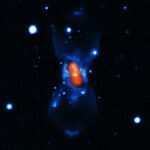Space

A set of enigmatic quasar ghosts mark the graves of these objects that flickered to life and then faded.
8 unusual looped structures orbit their host galaxies and glow in a bright and eerie goblin-green hue. The ethereal wisps in these images were illuminated, perhaps briefly, by a blast of radiation from a quasar - a very luminous and compact region that surrounds a supermassive black hole at the center of a galaxy - and Hubble was there to catch it.
The first object of this type was found in 2007 by Dutch schoolteacher Hanny van Arkel participating in the Galaxy Zoo project, which…

Chinese Chang’e 3 spacecraft on Dec. 14, 2013 became the first probe to soft land on the Moon since the Soviet Union's Luna 24 in 1976.
Other missions could follow its footsteps soon as the commercial teams participating in the Google Lunar XPRIZE competition, gear up fiercely to conquer the Moon. But the lunar soft landing is a tough one, only achieved by three state-run space agencies so far. A truly exceptional and tricky endeavor. “It really is an extraordinary challenge to land softly on the Moon so we think that only a small number of teams will be able to do it,” Andrew Barton,…

Cosmologists may have discovered what could be the precursors of the vast clusters of galaxies that we see today. Galaxies like our Milky Way, with its 100 billion stars, are usually not found in isolation. 13.8 billion years after the Big Bang, many are in dense clusters of tens, hundreds or even thousands of galaxies.
How did such massive structures assemble in the early Universe? Using data combined from SA’s Herschel and Planck space observatories, astronomers have found objects in the distant Universe, seen at a time when it was only three billion years old, which could be…

European Intermediate eXperimental Vehicle (IXV) was launched on a Vega rocket from Europe’s Spaceport in French Guiana on Feb. 11.
The spacecraft was then released into a suborbital trajectory, and flew autonomously, reentering and splashing down into the Pacific Ocean after 100 minutes. This crucial test for ESA has exceeded scientists’ expectations as IXV behaved flawlessly, responding to conditions so precisely and promptly.
“The launch was a complete success, all parameters collected so far confirm that the vehicle behaved well, as planned,” Stephane Dussy, IXV Spacecraft Operations…

The study of fluids in motion – now known as hydrodynamics – goes back to the Egyptians so it has been involved in a lot of experiments but now it has provided something new; experimental evidence that stars may generate...sound.
When examining the interaction between an ultra-intense laser and a plasma target, a team of scientists from the Science and Technology Facilities Council’s (STFC) Central Laser Facility in Oxfordshire, the York Plasma Institute at the University of York, and the Tata Institute of Fundamental Research in Mumbai, India, noticed something unusual. They realized…

Dark matter is an umbrella term for matter that no one has directly detected but must be out there or physics at the very large scale makes even less sense than it makes now. Since it does not reflect, absorb or emit light, it is invisible, so whatever it 'is' is only known to exist via its gravitational effects on matter as we know it.
That makes it difficult for science - but we can basically learn something about dark matter the same way we originally did with detectable matter - by studying what happens when it bumps into things. But since it is undetectable that can only happen on scales…

We may have Jupiter to thank for our unusual solar system.
Before the inner planets we now call Mercury, Venus, Earth, and Mars formed, a great inward-and-then-outward journey that Jupiter made early in the solar system's history may have torn apart a number of super-Earths - planets larger than Earth but smaller than Neptune - and caused their giant remnants to fall into the sun billions of years ago.
This possible scenario has been suggested by Konstantin Batygin, a Caltech planetary scientist, and Gregory Laughlin of UC Santa Cruz in a PNAS paper. Their…

One of astronomy's big questions is why galaxies forming as recently as 1 billion years after the Big Bang contain so much dust. The leading hypothesis is that supernovae, stars that explode at the end of their lives, contain large amounts of metal-enriched material that, in turn, harbors key ingredients of dust, like silicon, iron and carbon.
When a supernova explodes, the materials in its center expand and form dust. This has been observed in several young supernova remnants - such as the famed SN1987A and Cassiopeia A. In the turbulent supernova environment, scientists expect the churning…

In 1670, the greatest astronomers, including Cassini and Hevelius, the father of lunar cartography, documented the appearance of a new star in the skies.
Hevelius described it as nova sub capite Cygni — a new star below the head of the Swan — and now it is officially known it by the name Nova Vulpeculae 1670. It lies within the boundaries of the modern constellation of Vulpecula (The Fox), just across the border from Cygnus (The Swan) and is also referred to as Nova Vul 1670 and CK Vulpeculae, its designation as a variable star. Historical accounts of novae are rare and Nova…

Just like the Pharaoh Cheops, who ruled the ancient Old Kingdom of Egypt, ESA’s CHaracterising ExOPlanet Satellite (CHEOPS) could be someday ruling in the field of exoplanet hunting.
It will be the first mission dedicated to search for transits by means of ultrahigh precision photometry on bright stars already known to host planets. “CHEOPS looks at stars that are already known to host planets and attempts to observe transits. I say attempts because its main targets are planets that have been discovered through Doppler techniques,” Don Pollacco of the University of Warwick, UK…